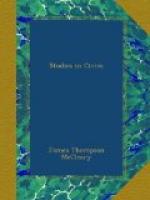Under this provision Washington was elected president twice and Adams once. In the disputed election of 1800, it was found that this mode would not do. The faulty feature in the plan is found in the first sentence, which requires the electors to vote for two persons for president. In this election, Jefferson and Burr, candidates of the same party, received the same number of votes and each had a majority. The power to choose then devolved upon the house of representatives. There were at that time sixteen states, and consequently sixteen votes. Of these Jefferson received eight, Burr six, and the remaining two were “scattering.” As it required nine votes to make a majority, no one was elected. The balloting was continued for seven days, thirty-six ballots being taken. On the thirty-sixth ballot Jefferson received ten votes to four for Burr. Jefferson thus became president and Burr vice-president. But the consequent bitterness of feeling was much regretted, and it was determined to change, slightly, the mode of election. The changes consisted in having the electors vote for one person for president and for a different person for vice-president; and when the election is thrown into the house of representatives, the selection is to be made from the three highest instead of the five highest as originally. The change was made by the twelfth amendment, passed in 1804, which is here given in full.
The Twelfth Amendment.
The electors shall meet in their respective states and vote by ballot for president and vice-president, one of whom, at least, shall not be an inhabitant of the same state with themselves; they shall name in their ballots the person voted for as president, and in distinct ballots the person voted for as vice-president, and they shall make distinct lists of all persons voted for as president, and of all persons voted for as vice-president, and of the number of votes for each; which lists they shall sign and certify, and transmit sealed to the seat of government of the United States, directed to the president of the senate. The president of the senate shall, in the presence of the senate and house of representatives, open all the certificates, and the votes shall then be counted;




